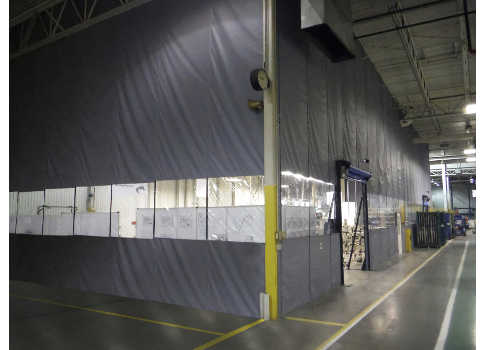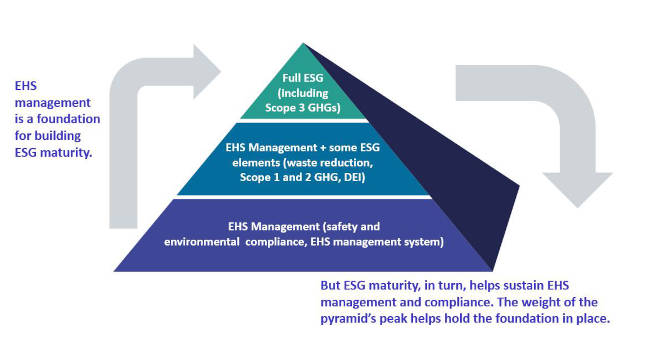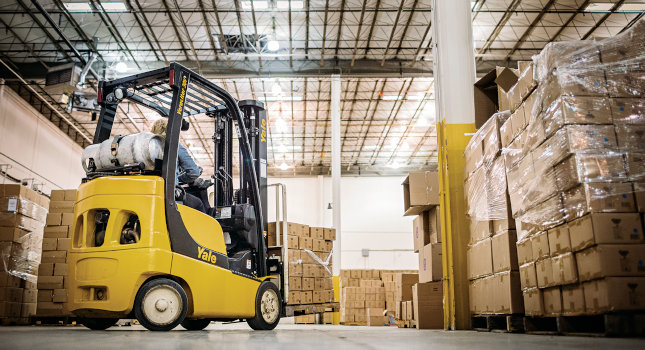Curtain walls and HVLS fans can improve air particulate exhaustion.

The containment of dust and other air particulates is one of the biggest quality control challenges in virtually any industry. A common byproduct of operations like cutting, grinding, welding, and mixing, air particulate can also cause a host of safety issues. Given the range of potential problems it can cause, in-plant dust/particulates are a dangerous issue that simply can’t be ignored. Any company engaged in a process handling or particulate generating operation will benefit from proper control practices.
The troubles with air particulate
Dust on plant equipment or any other surface in the facility is a matter of constant attention for cleaning and maintenance. Uncontrolled particulate matter can spoil or degrade batches of differing critical materials and ruin products. But even greater issues than diminished product quality can arise.
Immediate safety problems, including fires and explosions, can occur when there is a high enough concentration of airborne particulate in an enclosed space. Additionally, long-term health concerns exist for employees working where airborne particulate is present. The issue of air quality is both a short-term and long-term issue for any controlled environment.
Controlling particulate contamination
The most common methods used to prevent particulate from one space contaminating another are exhaust separation and barrier separation. Exhaust separation methods rely on moving a volume of air containing the contaminate particles through exhaust fans through ducts to create a negative air pressure environment.
In a clean space that generates no particulates but is adjacent to a particulate-intensive area, a positive air pressure environment is desired. To achieve this, filtered air is pumped into the clean space, preventing the inward flow of air that might contain foreign particulate matter.
In some cases, a simple partition or wall between a clean space and an uncontrolled ambient space (such as between a processing area and a loading dock) is an effective means of separation. If a negative air pressure differential exists across the wall between the clean and ambient space, the wall acts as a physical barrier, blocking most of the foreign matter from crossing the barrier. Depending on the degree of particle separation required, and the need and frequency for traffic to move through the partition, a more effective solution would be to introduce a positive air pressure differential to the clean space, as described in the previous paragraph.
The smaller a space can be made, the smaller the exhaust equipment can be specified. Partitioning around a dust source takes full advantage of this relationship. Reducing the volume of the space to be exhausted means smaller fans can be used, which reduces total air movement. Lower air velocity through filter media increases the effective particle separation of the device. Additionally, lower airflow through the filter reduces the frequency required for change out or cleaning.
However, plants with frequently changing layouts will find permanent walls are rarely a good option.
The value of fabric curtain walls
Fabric curtain walls also allow separation between processing areas and clean rooms or finishing areas. Curtain walls also can be reconfigured if the facility layout changes.
In a situation where a positive pressure space is desired, some sort of enclosure (or "box") around the space would be optimal to maintain the pressure differential. Fabric curtain walls are less expensive to install than hard walls and create a comparable enclosure seal to a hard wall.
The inclusion of standalone, high-speed roll-up doors in the curtain wall allows for efficient thoroughfare while minimizing time the interior is open to the processing area. In the same way as a permanent wall, fabric curtain walls act as a physical barrier, blocking particle transfer. Because they are made of flexible fabric, they also are relatively easy to reconfigure if a space needs to be enlarged, reduced, or the shape of the space footprint needs to change. Fabric curtain walls can be trimmed to fit around conduit, piping, ductwork, or other permanent infrastructure and can be anchored to the floor to withstand pressure differential across them.
HVLS fans can play a role
Increasing ventilation rates and air distribution often can be a cost-effective way to reduce indoor pollutant levels, as well. HVAC systems should be designed to meet ventilation standards in local building codes; however, many systems are not operated or maintained in a way that ensures these design ventilation rates are achieved. In operations that do not produce abundant air particulate matter, high-velocity, low-speed (HVLS) fans can provide constant air movement that disperses concentrations of these airborne contaminants.
This gentle mixing of air also offers workers relief from the heat. HVLS fans can keep workers cool and more productive. Slight breezes of only 2 to 3 mph can provide a cooling sensation of up to 11 F, which can provide significant relief for workers operating in hot welding, cutting, or production areas.
When considering HVLS fans, issues such as including the location of pallet racks, machinery, product staging areas, personnel work areas, and overall building layout should be considered. Small-diameter fans will be more effective in specific work areas or where installation space is limited. However, fans up to 24 feet in diameter can cover areas up to 22,000 square feet and can move air over obstructions.
Maximizing air particulate control efficiencies Plants requiring air particulate control stand to benefit from curtain walls. As a flexible and economical way to partition space, curtain walls can be effective for exhaust, supply, and separation systems, regardless of the application. HVLS fans are a cost-effective way to provide optimal airflow and particulate dispersion in the large open spaces that exist in most plants.
– Chuck Ashelin is an engineering manager for Zoneworks.



